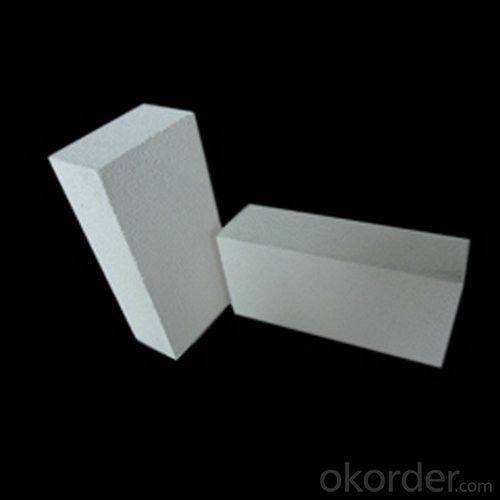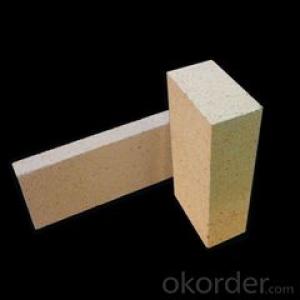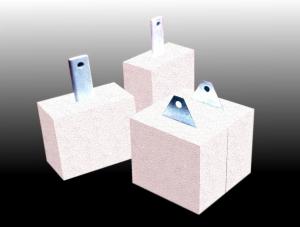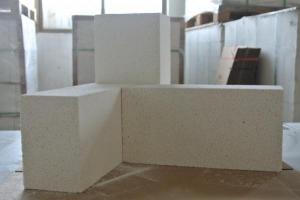Insulating Fire Brick - GJM Insulation Brick Insulating Brick
- Loading Port:
- Shanghai
- Payment Terms:
- TT or LC
- Min Order Qty:
- 1000 pc
- Supply Capability:
- 100000000 pc/month
OKorder Service Pledge
OKorder Financial Service
You Might Also Like
General information of Insulating Brick
Insulating firebricks are classified under tempera-ture between 1100C to 1700C, manufactured from high purity alumina clay.
Insulating fire bricks are made from high purity alumina and low iron content raw materials. The insulating fire bricks are produced by mixing, casting or extruding, drying, sintering and grinding. Our insulating fire bricks GJM23 temperature is 1260℃(2300℉). A variety of type could be done according to customer’s request.
To make our firebricks more energy and cost effective, we have different manufacturing methods for our insulating fire bricks casting and extruding method.
For insulating fire bricks GJM23,we choose the casting methord.The casting insulating fire bricks offering the lowest density, the lowest thermal conductivity for the application above 1000℃.
Application of Insulation brick
Insulating firebricks can be used as a hot face lining directly exposed to the heat or as a backup insulation layerin iron and steel mills, non-ferrous foundries, petrochemical, ceramic, glass.
Features of Insulation brick
◆Light weight and low thermal conductivity
◆Low heat storage
◆Low iron and impurities
◆High thermal shock resistance
Technical Data of GJM series Insulation brick
| JM23 | JM26 | JM28 | JM30 | JM32 | ||||
| Physical Properties: | ||||||||
| Classifiction Temperature | ℃ | 1260.0 | 1430.0 | 1500.0 | 1600.0 | 1650 | ||
| Density | Kg/m3 | 550.0 | 850.0 | 900.0 | 1000.0 | 1100 | ||
| Cold Crushing Strength | Mpa | 1.2 | 2.0 | 2.5 | 2.8 | 3.5 | ||
| Reheating Linear Change(24hrs) | ||||||||
| 1230℃ | % | 0.4 | ||||||
| 1300℃ | ||||||||
| 1400℃ | % | 0.5 | ||||||
| 1510℃ | % | 0.6 | ||||||
| 1600℃ | % | 0.7 | ||||||
| 1650℃ | % | 0.8 | ||||||
| Hot Load Strength Deform(90 minutes) | ||||||||
| 1100℃ at 0.034 Mpa(5psi) | % | 0.1 | ||||||
| 1260℃ at 0.069 Mpa(10psi) | % | 0.2 | ||||||
| 1320℃ at 0.069 Mpa(10psi) | % | 0.3 | ||||||
| 1370℃ at 0.069 Mpa(10psi) | % | 0.2 | 0.1 | |||||
| Thermal Conductivity | ||||||||
| 400℃ | W/m.k | 0.2 | 0.3 | 0.3 | 0.3 | 0.32 | ||
| 600℃ | W/m.k | 0.2 | 0.3 | 0.3 | 0.3 | 0.35 | ||
| 800℃ | W/m.k | 0.2 | 0.3 | 0.4 | 0.4 | 0.38 | ||
| 1000℃ | W/m.k | 0.2 | 0.3 | 0.4 | 0.4 | 0.42 | ||
| 1200℃ | W/m.k | 0.4 | 0.4 | 0.4 | 0.44 | |||
| 1400℃ | W/m.k | |||||||
| Specific Heat | KJ/Kg.K | 1.1 | 1.1 | 1.1 | 1.1 | 1.10 | ||
| Chemical Analysis: | ||||||||
| Al2O3 | % | 47.0 | 50.0 | 60.0 | 70.0 | 75.0 | ||
| SiO2 | % | 44.4 | 47.1 | 38.2 | 28.3 | 23.2 | ||
| Fe2O3 | % | 0.9 | 0.7 | 0.6 | 0.5 | 0.5 | ||
| TiO2 | % | 1.2 | 0.1 | 0.1 | 0.1 | 0.1 | ||
| CaO | % | 5.2 | 0.1 | 0.1 | 0.1 | 0.1 | ||
| MgO | % | 0.3 | 0.2 | 0.1 | 0.1 | 0.1 | ||
| Na2O+K2O | % | 1.1 | 1.7 | 0.8 | 0.7 | 0.6 | ||
Technical Data of B series Insulation Brick
| B-1 | B-2 | B-3 | B-4 | B-5 | B-6 | B-7 | ||||
| Physical Properties: | ||||||||||
| Density | g/cm3 | 0.7 | 0.7 | 0.75 | 0.80 | 0.80 | 0.90 | 1.00 | ||
| Cold Crushing Strength | Mpa | 2.5 | 2.5 | 2.5 | 2.5 | 2.5 | 3.0 | 3.0 | ||
| Thermal Conductivity 350℃ | W/m.k | 0.17 | 0.18 | 0.20 | 0.22 | 0.23 | 0.27 | 0.31 | ||
Technical Data of C series Insulation Brick
| C-1 | C-2 | C-3 | ||||
| Physical Properties: | ||||||
| Density | g/cm3 | 1.1 | 1.2 | 1.3 | ||
| Cold Crushing Strength | Mpa | 5.0 | 7.0 | 10.0 | ||
| Thermal Conductivity 350℃ | W/m.k | 0.30 | 0.38 | 0.45 | ||
Photo of Insulation Brick






- Q: Can insulating fire bricks be used in the construction of lime recovery kilns?
- Yes, insulating fire bricks can be used in the construction of lime recovery kilns. These bricks are designed to withstand high temperatures and provide excellent thermal insulation, making them suitable for such applications. They help to conserve energy and maintain the desired temperature within the kiln, enhancing the efficiency of the lime recovery process.
- Q: Can insulating fire bricks be custom-made?
- Yes, insulating fire bricks can be custom-made. Insulating fire bricks are typically made from lightweight materials such as vermiculite, perlite, or refractory fibers, which can be easily molded into various shapes and sizes. This flexibility allows manufacturers to create custom-made insulating fire bricks to meet specific requirements and applications. Customization options may include variations in dimensions, thermal conductivity, compressive strength, and density. By tailoring the composition and design of insulating fire bricks, they can be optimized for specific temperature ranges, insulation requirements, and environmental conditions. Therefore, customers can work with manufacturers to develop custom solutions that best suit their unique needs.
- Q: Can insulating fire bricks be used in outdoor fire pits?
- Certainly, outdoor fire pits can make use of insulating fire bricks. These bricks are specifically engineered to endure high temperatures, rendering them suitable for fire pit applications. They are crafted from heat-resistant materials like ceramic fibers or refractory substances, which aid in preserving the heat within the fire pit. Moreover, insulating fire bricks possess a lightweight composition and are effortless to install, making them a practical selection for outdoor fire pits. Nevertheless, it is crucial to bear in mind that these bricks may not possess the same level of durability as regular fire bricks. Thus, they might necessitate more frequent replacement if exposed to extreme temperatures or harsh weather conditions.
- Q: Can insulating fire bricks be used in both residential and industrial applications?
- Yes, insulating fire bricks can be used in both residential and industrial applications. They are commonly used in residential fireplaces and wood-burning stoves for their insulating properties, as well as in industrial furnaces, kilns, and ovens to retain heat and improve energy efficiency.
- Q: Can insulating fire bricks be used in drying ovens?
- Yes, insulating fire bricks can be used in drying ovens. Insulating fire bricks are designed to have low thermal conductivity, which makes them an excellent choice for applications that require heat insulation, such as drying ovens. These bricks can withstand high temperatures and provide insulation to help maintain the desired temperature inside the oven, while also reducing heat loss to the surroundings. Additionally, insulating fire bricks are lightweight and easy to install, making them a practical choice for use in drying ovens.
- Q: Can insulating fire bricks be used for insulation in industrial chimneys?
- Yes, insulating fire bricks can be used for insulation in industrial chimneys. Insulating fire bricks are specifically designed to withstand high temperatures and provide excellent insulation properties. They are made from lightweight refractory materials that have low thermal conductivity, allowing them to effectively retain heat and prevent its transfer to the surroundings. This makes them ideal for use in industrial chimneys, where insulation is crucial to minimize heat loss and improve energy efficiency. Additionally, insulating fire bricks are also resistant to chemical corrosion, making them suitable for the harsh and corrosive environments typically found in industrial chimneys.
- Q: Can insulating fire bricks be used in the construction of combustion chambers?
- The use of insulating fire bricks in combustion chambers is highly recommended. These bricks are created using lightweight, porous materials that possess exceptional thermal insulation capabilities. As a result, they are extremely suitable for high-temperature applications like combustion chambers, where their insulation aids in the containment and regulation of heat generated during the combustion process. The heat transfer resistance of insulating fire bricks is notably high, enabling them to effectively retain heat within the combustion chamber. This, in turn, enhances combustion process efficiency by minimizing heat loss to the surrounding environment. Moreover, these bricks' insulating properties help prevent the outer walls of the combustion chamber from overheating, thereby reducing the risk of structural damage. Furthermore, insulating fire bricks are specifically designed to endure elevated temperatures, rendering them highly durable and resilient. This is particularly crucial in combustion chambers, where intense heat and varying temperatures are commonplace. Their ability to withstand thermal shock and thermal cycling makes them a dependable choice for this purpose. To summarize, insulating fire bricks are an exceptional option for constructing combustion chambers due to their thermal insulation properties, heat retention ability, and resistance to high temperatures. They significantly contribute to the overall efficiency and safety of the combustion process, making them an invaluable component in combustion chamber construction.
- Q: Are insulating fire bricks resistant to warping?
- Insulating fire bricks are known for their resistance to warping. They are specifically designed to withstand high temperatures and thermal shocks, preventing any potential warping. These bricks are crafted using lightweight materials like clay, silica, and alumina, which are combined with additives to enhance their insulation capabilities. Moreover, these additives not only contribute to the brick's insulation, but also aid in its resistance against warping. Furthermore, insulating fire bricks undergo a meticulous manufacturing process that ensures dimensional stability and reduces the risk of warping. It is worth mentioning, however, that prolonged and extreme exposure to high temperatures may still result in some warping, albeit to a lesser extent than other brick types.
- Q: Why does the water drop first and then rise when the boiler fires?
- Often in the operation of the boiler, the steam water mixture to the drum after intense evaporation of a large number of bubbles in the water side, the water volume expansion. By actual water level drum water level indicator is higher than the water level
- Q: Are there any safety precautions to consider when using insulating fire bricks?
- Yes, there are safety precautions to consider when using insulating fire bricks. Firstly, it is important to wear appropriate personal protective equipment, such as gloves and safety goggles, to protect against potential injuries. Additionally, due to the high temperatures involved, it is crucial to handle the bricks with care to avoid burns or related accidents. Adequate ventilation should be ensured to prevent the buildup of harmful gases and fumes. Lastly, it is essential to follow the manufacturer's instructions and guidelines for proper installation and usage to minimize any potential risks.
Send your message to us
Insulating Fire Brick - GJM Insulation Brick Insulating Brick
- Loading Port:
- Shanghai
- Payment Terms:
- TT or LC
- Min Order Qty:
- 1000 pc
- Supply Capability:
- 100000000 pc/month
OKorder Service Pledge
OKorder Financial Service
Similar products
Hot products
Hot Searches
Related keywords


























